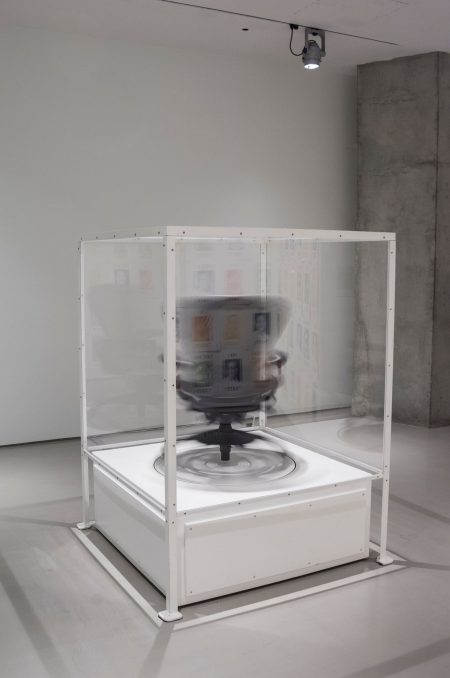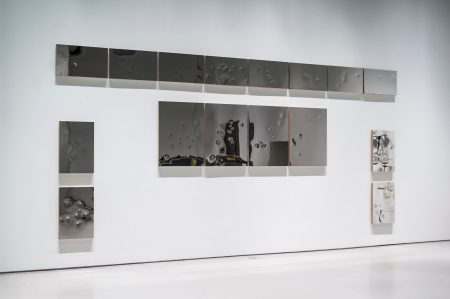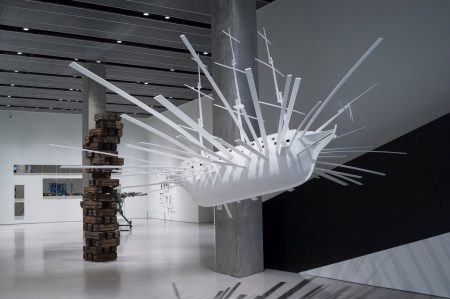One of the least sculptural of the wondrous works at the mid-career retrospective of sculptor Glenn Kaino’s work at the Contemporary Arts Center is a two-dimensional graphic that looks like an ancient map that has been housed in an archive with a leaky roof. Shapes and outlines are beautiful but discontinuous; areas that might represent oceans also look like clouds seen from above, white blotches that obscure detail. The certainty of the map merges with the uncertainty of the world the map purports to represent. The scalloped edges of the continents are even more beautiful in their simulated decay. The originals of these cartographic fragments are, we are told, from a map (now in pieces at the Topkapi Museum) produced by Piri Reis, a 16th century Turkish pirate who seems to have gone straight and become an admiral. He produced maps that are highly suggestive of the very latest word to have reached the Old World about the shapes and longitudes of the New. Like some other works in the show, the wall texts describe a back story so exuberantly colorful that they might be taken for performance pieces, if they did not also check out on Wikipedia.
Maps and topographies—though more typically in three-dimensional form–are part of the essence of Kaino’s work. Maps are codes for space, and topographies are about how space is occupied by shapes. The work is entitled “Knowledge Transfer” (2011), a wickedly accurate account of the object and the show as a whole. The map is itself a print (a transfer) of a diagram that takes the work of a number of previous mapmakers of the world, from medieval artisans to Columbus, and enables their diagrams to move between and among cultures (a knowledge transfer). This map itself is a vastly hybrid text, combining elements from different historical cultures, and then further hybridized by Kaino, whose lovely manipulations of an ancient text create something beautiful and new from the fragments of the old. There is a word for this: “kit-bashing.”

“Kit-bashing,” as the wall text explains, is “a term used by model makers to refer to the experimental production of hybridized objects by combining pieces from multiple kits into one.” The term is rooted in such projects as the first Star Wars film, where ships like the Millennium Falcon were put together from pieces of various other craft, from rockets to World War II torpedo bombers. The exhibit has some classic pieces of kit-bashing in works like “In Search of a New Model (Photosphere),” where tiny, semi-precious objects are displayed under glass suspended on pins, like a naturalist’s exotic specimens. Some pieces are easy to decode—there are tiny golden guns and shovels—and some are not. There is a randomness to their arrangement, though they feel as if they are trying to resolve themselves into a diagram, like the map of a galaxy with which we are not familiar. It takes a special patience to allow these pieces not to have to give up their autonomy and settle into the more mundane business of becoming a whole. In the gallery, they are splayed out elegantly; I feel sure that this is the way the glittering pieces of one of my plastic model airplanes looked like to me before I started to glue them together. As a parent, I feel sure now that to my mother, they must have looked like a chaotic mess.

Other examples of kit-bashing suggest the roots of such activities in surrealism and the grotesque. In pieces like “Graft (Ostrich)” (2008) or “Graft (Salmon)” (2006), Kaino covers a model of one animal with swatches of skin from another: the life-sized ostrich is decked out in python skin, while the model of the salmon is covered with irregular pieces of coarsely-stitched shark skin, until it looks like our images of Frankenstein’s monster. Kaino calls these pieces his “proud hybrids,” and identifies them as some of his most personal works in the show; they are in part about the Asian diaspora, Kaino comments, and Japanese assimilation, representing a “proud way of not fitting in.” They are creatures who are remaking themselves in a new image and are proud of the new skin they wear, though there is something trophy-like about them. They cannot speak for themselves—they are in a long tradition of the ways that humans have colonized their world and put on display what they understand of whatever they have conquered.
What does a piece do for itself? Perhaps it is a sign of how extraordinary some of these sculptures can be that they raise such interesting questions about their own autonomy. One installation, “L’enetenafionale” (2016), off in a dark room by itself, has a pale marionette impersonation of Franz Fanon (we are told) sitting on a crescent moon, evocative of a puppet show or carnival. As you draw closer, the moon, it turns out, is something of a puppet too, and startlingly moves its eye to give you the once-over. Apparently, when enough of a crowd has gathered, the puppet sings. Since I was only in that room by myself, I will have to take the curator’s word for it. On the one hand, it made me realize that I bring something of a colonializer’s frame of mind to the works of art I peruse; I’m there and I expect them to perform (and reveal themselves) for me. On the other hand, it’s strange and off-putting that the work of art makes decisions about—and chooses—its audience. Autonomy is also raised as an issue in “Spontaneous Combustion” (2017), where Kaino has coated American flags with a tarring compound, bound them up tightly, and waits for them to burst into flame by themselves. The natural climax of the piece, as the flags smolder fiercely, is something that the artist cannot quite control. But we see a video of Kaino untying and unfurling a chemically soaked flag very, very gingerly, showing an entirely natural anxiety about those moments when the object will speak for itself. There are risks associated with agency.
Sometimes it is hard to see the personal element in the show. Though one piece consists of dozens and dozens of color prints of Kaino’s face (in a piece that I found unconvincing in its depiction of a protest against a perceived Western resistance to Asian food), more often the personal is erased or redacted. In a very arresting piece called “The Siege Perilous” (2003), an office chair housed in a large, clear museum case whirls up to an alarming 200 revolutions per minute. The title takes us back to the age of heroism and pays homage to the seat Merlin required to be left empty at the Round Table until the greatest hero, the one who could recover the Grail, could occupy it. The title also connects it to the world of X-Men, where the Siege Perilous is a portal, a way to enter an alternate world, which suggests again the range of ways Kaino represents maps to other spaces. The revolving chair on display plays a kind of keep-away. It slows but never stops; our world is not able or sufficiently worthy to occupy it. As the chair swivels at its top speeds, it resembles in profile an immaterial chalice. It is a strong and evocative piece, its blackness seeming vaguely post-apocalyptic and yet rich with its own spiritual life, rising from the ashes of materiality.

But the wall text goes a good deal further. As the wall texts in this exhibit frequently do, it argues for a specificity that is not self-evident from the object itself. It identifies the chair as “Herman Miller’s Aeron Chair,” and explains that it is “the chair that hundreds of start-up companies spent much of their investment money buying as a quick shortcut to the image of power and the appearance of success.” It goes on to connect it to the years Kaino spent in the dot-com world, working, in his case, for Napster and Universal Music. But if that connection is to be made, I found it disappointing that the piece has no visible element of self-indictment on Kaino’s part for those years of culpable buy-in. I don’t know that I was expecting the pieces to be confessional—there is a notorious coolness to the postmodern—but the show raises questions about how a work of art becomes political, and how we are to be able to perceive and appreciate the political in it.
Near the entrance of the show is a substantial wall installation with large sheets of highly reflective stainless steel arranged in a relatively banal way, as if they were elements at an architect’s office being made ready for some sort of triumphalist building (“Now Do I Repay a Perfect Won” [Syria] [2014]). But the stainless steel bears signs of contention: every sheet is randomly blemished with dents. Though it feels as if we are supposed to think that people have been throwing rocks at the walls of United States embassies, the piece itself bears no sign of the passion of those who are co-creators, of sorts, of the finished piece. (We never find out exactly how the dents were actually made.) And with the traceries of violence comes a new beauty—in most every way, the dents add to rather than take away from the piece’s overall visual interest. Close up, the individual dents become parabolic mirrors; in addition to seeing your own reflection, which is a bit startling regardless of how much you expect it, you can see in the dents deliciously warped views of much of the rest of the gallery space and the other pieces installed there. A terrible beauty is born. It seems to suggest that history is palimpsestic: every interaction between objects and a human population leaves a new layer of marks and meanings, layered maps of its exposure to other people’s protests.

The wall text, as before, adds an additional level of specificity that perhaps changes the nature of the political presence of the piece: “The original portals in countries and cities such as Benghazi, Damascus, Yemen, Turkey, Cairo, Athens, and Sudan bent without breaking….As a metaphor for American foreign policy, these battered mirrors reflect a contentious state between extending aid and protection around the world, as well as the overreach of military and economically-fueled aggressions.” I see in myself a desire to over-aestheticize the pieces, which I think I have the strength to resist. But I also caught myself wondering what this really means in 2018. “A metaphor for American foreign policy”? In the Age of Trump, what on earth would that be? I know how to say that western capitalism’s hegemonic interests remain unchanged whether someone new, or no one at all, is at the helm. But I think that there is something wrong with that sort of universalism. I felt that the more the wall texts call for extreme specificity, the more they are pushing the political elements in a work of art towards the most general—and the more they tended to discount the immediacy of the confrontation between the viewer and the thing itself. It seemed to me as if the political subtext was getting priority over the potentially political text.
It matters because, to the inquiring eye, there is already an element of the aestheticized, the mysterious, and the spiritual in Kaino’s political work. “A Shout Within a Storm” (2014) is probably his best-known work. The exhibit as a whole is named after it. A fleet of more than a hundred full-size copper arrows hang from the ceiling, frozen in flight, as they converge with destructive magnificence on a target that is not there. The fineness of Kaino’s materials, as well as the elegance of his craftsmanship, is almost always on view in the show. This is not the protest of an indigenous group or the white-hot passion of, really, anyone. The frozen energy of the piece seems elegiac. It seemed reminiscent of the flights of countless airborne arrows at the end of Yimou Zhang’s 2002 movie Hero as they are about to terminate Jet Li. There is no sign of where the arrows are coming from (that interesting puzzle of agency again), and though they were once speeding on their way towards their target, we don’t know what, besides the air, is on the receiving end. It is a demonstration of force that keeps its secret.

The wall text offers an explanation, of a sort. The piece, we are told, is inspired by the writings of a late-twentieth century Zapatista rebel who went by the name of “Marcos,” whose brief insurrection was crushed and whose legacy gradually lost connection with the Zapatistas’ actual leader: “The legacy and ideas of ‘Marcos’ have thereby endured as an entity beyond the individual.” Marcos, we are told, adopted a series of pseudonyms until “in May 2014 he announced that Subcommandante Marcos was a hologram that ‘no longer exists’….” Once again, despite the intensity of the particular claims the wall text makes for the piece, we are left with a work that erases the actual individual. Rather than making “Marcos” more visible and a participant in the political struggles of his world, the piece makes him seem like a performance piece: a dramatic fiction.
I wasn’t always sure what was Kaino’s take on political violence—the sort of violence that seems most interesting to him. Is it liberatory? Ecstatic? Transformative? Available to be assembled into art? In “A Plank for Every Pirate” (2006), a stark white boat with two-prows (remember how Kaino is drawn towards the idioms of surrealism) is suspended from the ceiling, rolling through an imaginary rough sea. From its sides extend dozens of flat boards each almost as long as the main mast. They are planks, of course, because we know the features of a pirate ship, and they bristle like a bleached porcupine, or a badly-designed set of oars for a Roman galley. By what metaphorical logic are there so many? Is the ship as pale as a ghost because each pirate has forced his colleagues to walk a plank, leaving the ship a Flying Dutchman emptied of life?

The wall text calls attention to Kaino’s “hard-fought appreciation for pirates as radicals with an aesthetic flair that underpins their anarchism,” and celebrates the “rogue activist groups who have actively sought to create a more promising world.” Though Kaino comments that “each plank would be as individual as the pirate,” that is simply visually not the case. He proposes to honor every rebellious act as potentially being performed by a visionary, but the work is so striking in large part because the planks are no more different from each other than are, say, the masts. The piece’s playful elegance comes partly from the cancellation of the individuality of all the radicals it seems to want to single out. It matters because each possibility represents a different vision of political actions and actors, and problematizes the relationship between the parts and the whole.
“Suspended Animation” (2014) consists of a conveyor belt at rest (though apparently balancing on only one set of wheels), frozen in place like the flights of arrows. Along the belt, in a patient row, are rocks and debris “collected from protest sites around the world.” As we have seen before, they exist in the wall text with a great deal more specificity than they have as an object on display: “these shards were collected by friends and colleagues in Egypt, Yemen, the Philippines, Indonesia, Crimea, Benghazi, Ferguson, MO and other places that have seen uprisings against police, military, and governmental actions.” Like so many other things in a museum, the individual stones have become mysterious, fetishized, and precious, though they may have started out as examples of whatever comes to hand when outraged political convictions blossom into action. Placing them on the conveyor belt reminds us how quickly the individual pieces can be reduced once again to rubble. But for now, artfully placed, they are another example of kit-bashing. The conveyor belt is just about at eye-level; in their new identity, the procession of stones form a kind of horizon line, and rocks can be taken for a miniaturization of distant hills and badlands. It is the bulkiest map in the show.

“A Shout within a Storm” sometimes reads like two shows that don’t quite fit together. One, which we experience mostly through the wall texts, is polemical. It argues over and over again that political art emerges from the contemplation and efforts of aggrieved individuals, moved to resist. I am not convinced that this argument is what is perceived by the viewer in the gallery space, and—perhaps more important—that it is what the viewer feels. The other show celebrates kit-bashing more generally. The artist is someone who seizes the raw materials of political frustration and transforms them with wit and craft. They are maps in that they try to orient us towards the starting places of their political and cultural lives. While they sometimes show us how once-precious objects—like the stainless steel panels worthy of a bland government building—can be trashed, they also suggest that potential trash can be transformed into precious objects. Kaino’s retrospective is an almost invariably handsome show—and sometimes a frustrating one—that invited me to admire Kaino’s sculptural sense, and even sculpture in general. It seemed a celebration of sculpture’s classic mission: to find and assemble objects, and place them, magically, into space.